#jiaqing era
Text
Abridged History of Qing Dynasty Han Women’s Fashion (part 5: Late Qianlong & Jiaqing eras)

(artwork from 1782)
Previous posts:
Late Ming & Shunzhi era
Kangxi era
Late Kangxi & Yongzheng eras
Qianlong era
The last two decades of the Qianlong era, the 1780s and 90s, formed one aesthetic continuity with the reign of Qianlong’s successor Jiaqing (1796-1820). This period was characterized by a turn to extreme formal simplicity and what I believe to be a revival of the tastes of the Ming-Qing transition.
We see sleeves of women’s robes, tight fitting and short to create a practical look in the previous era, become wider and longer. The folded cuff design was retained, though now more difficult to manage as the sleeves became wider. In the last post I discussed how the construction of dajin similar to Manchu men’s fashion became en vogue among Han women and replaced the earlier center front closing robes----this remained the same. We see some of the first instances of binding strips being used around the collar and the dajin, which would become a highly popular and elaborate craft later in the 19th century. Around this time, the binding strips used were usually thin and minimal, commonly of a black color. Plain cloth or bead tip buttons were popularized earlier in the Qianlong era, and metal clasp buttons (zimukou) became increasingly rare. The shape of the standing collar remained the same as that of previous centuries, soft, unstiffened and tall.
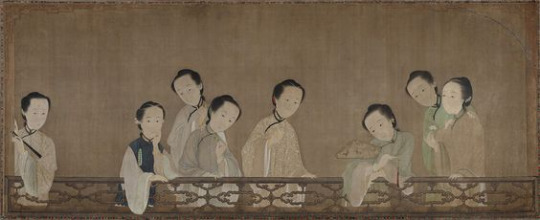
Artwork from 1796 showing a group of courtesans. You can see the black binding on some of their robes. A note about the dating of this artwork: while it’s quite a common reference image for Jiaqing era fashion, I wasn’t able to find an exact date until I read about it in the book Pictures for Pleasure and Use by James Cahill (spectacular book discussing the importance of vernacular and commercial art, highly recommend) and he said the date of creation was signed in the cyclical calendar and corresponds to either 1736 or 1796. He was inclined to 1736 because of “similar face shapes” or something to Yongzheng era artworks, but since he wasn’t a fashion historian he probably wasn’t aware that the fashions depicted here would not have been possible before the 1780s, so I think 1796 is instead the correct date.
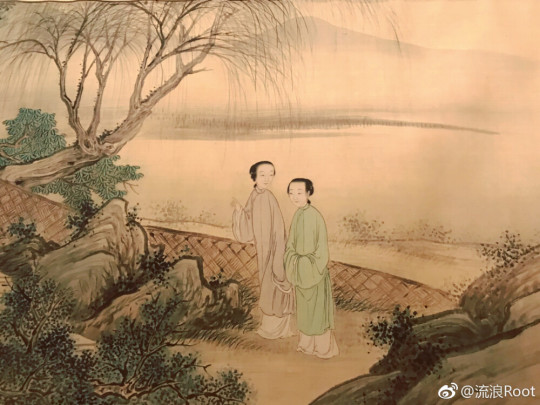
Late Qianlong/early Jiaqing era artwork, showing two austerely (and fashionably) dressed women.
The more radical departure from the previous era, however, was the complete eradication of ornament. Robes and skirts of this era were often entirely plain, with no brocaded patterns or embroidery of any kind. Gone were the roundel patterns, quatrefoil motifs on collar facings and decorative strips around skirts----only solid color blocks remained. Pastel colors like light pink, blue and green were among the most popular for robes besides bright blue and red, whereas skirts were white or black.

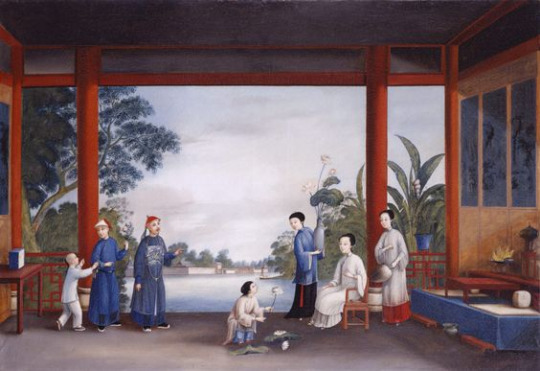
Late Qianlong/early Jiaqing era paintings of the Anglo-Chinese school showing the new style of plain garments.

Artwork from the era showing a woman in a light mustard robe with dusty pink cuffs, white skirt and red sash (sashes were still commonly worn).
The other significant changes happened in hairstyling. The 1780s did away with the iconic tall knots of the earlier Qianlong era, instead moving the mass and volume of hair toward the back. We see the re-emergence of the swallow tail. The front of the hair could be middle parted or completely pulled back. Flowers and other ornaments could be worn on the sides of the hairdo, behind the ears. The general shape of hairstyles stressed horizontality rather than verticality, as was the case before.
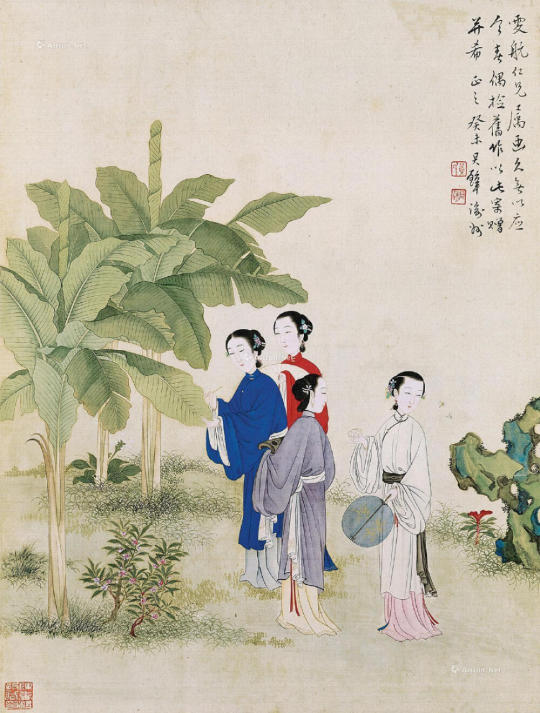
A 1943 copy of a turn of the 19th century original, showing the front and back of hairstyles.

Bust portrait showing the new hairstyle.
A unique hair accessory of the 1780s and 90s was a new iteration of the mo’e, which now had a sharply pointed triangular front and was worn high on the head instead of at the forehead. I think it became less common as the 19th century approached.
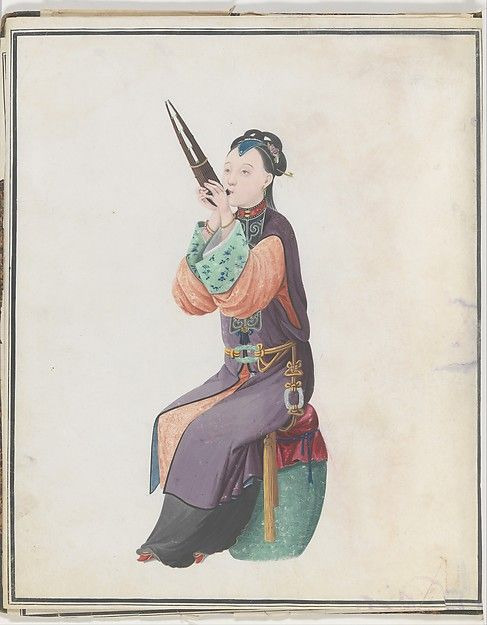
Export artwork showing a woman musician, likely 1770s or 80s as she is still wearing the ornamented, center front closing robes popular in previous decades.
Minimalism was not to last long, however, and soon decorative patterns began to reappear on robes, sleeve cuffs and skirts. Hairstyles began to gain volume and became more puffed, forming a sort of face framing crown. New styles of decorating skirts appeared, with binding going around the qunmen and the edge of each pleat, and embroidery on each individual pleat. The rectangular or circular patterned patch popular prior to the 1780s returned.

Early 19th century export painting at the Brighton Pavilion, maybe 1810s. We can see roundel patterns on the blue robe, embroidery on the cuffs and skirt, and the lady in red wears a pointed mo’e.

Presumably later Jiaqing era artwork, ca. 1810s, showing a group of women. Floral embroidery is present on the sleeve cuffs, the skirts are decorated.
#abridged history of qing dynasty han women's fashion#18th century#19th century#qianlong era#jiaqing era#qing dynasty#chinese fashion#fashion history#regency era
177 notes
·
View notes
Text

Day 26: Lady Wei, Empress Xiaoyichun
Lady Wei (like many women of her era, her personal name is lost to history) was a palace servant during the reign of the Qianlong Emperor. Her family was eventually raised to the nobility as the Weigiya, but that was thanks to her - they began as hereditary bond servants, if relatively elite ones.
Lady Wei seems to have been a servant for either - or both of - the Emperor’s influential mother, Lady Niohuru, or his beloved first wife, Empress Fucha. This enabled her to catch the Emperor’s eye, and in 1745, she entered his harem as Noble Lady Wei. Her rise after that was remarkably quick - she rose two ranks to Consort Ling before she’d even given birth to a child, and her ensuing four surviving children solidified her place in the Emperor’s favor.
In 1765, a figurative earthquake struck the court - Empress Nara, the Qianlong Emperor’s second wife and a previous Awesome Lady of History herself, was abruptly disgraced and stripped of power. Lady Wei, trusted by the Emperor, was promoted to Imperial Noble Consort, giving her most of an Empress’s duties but not the full title; duties she seems to have carried out diligently and well - perhaps too diligently and well for her health.
Lady Wei died in 1775, after a long illness exarbated by the death of her daughter, Gurun Princess Hejing. The Emperor, as he had done after the death of his first wife, wrote poems in her honor; he had already secretly selected her elder son, Yongyan, as his heir. Upon Qianlong’s “abdication” (as Emperor Emeritus, he retained his hold on the court - he had abdicated both as a show of filial piety towards his long-reigning grandfather and to better control a potential succession crisis), Yongyan became the Jiaqing Emperor - and Lady Wei was posthumously declared Empress.
#empress xiaoyichun#chinese history#qing dynasty#history#awesome ladies of history#october 2023#my art#watercolor pencils
9 notes
·
View notes
Photo
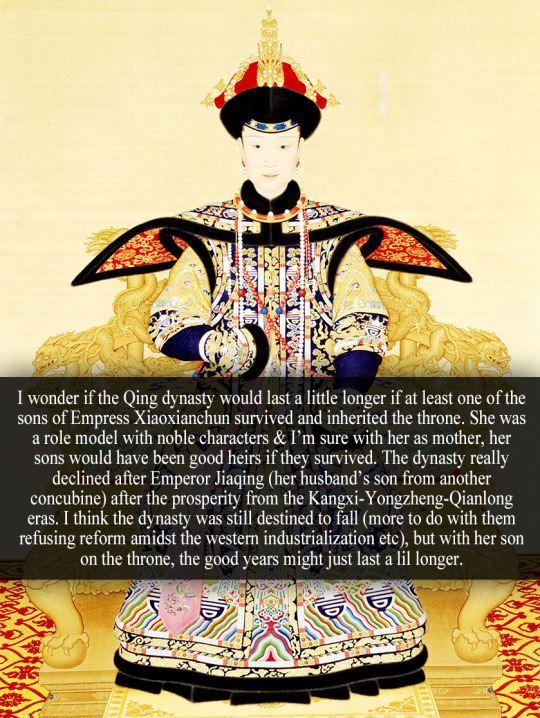
“I wonder if the Qing dynasty would last a little longer if at least one of the sons of Empress Xiaoxianchun survived and inherited the throne. She was a role model with noble characters & I’m sure with her as mother, her sons would have been good heirs if they survived. The dynasty really declined after Emperor Jiaqing (her husband’s son from another concubine) after the prosperity from the Kangxi-Yongzheng-Qianlong eras. I think the dynasty was still destined to fall (more to do with them refusing reform amidst the western industrialization etc), but with her son on the throne, the good years might just last a lil longer.” - Submitted by Anonymous
9 notes
·
View notes
Note
can you recommend one drama for each dynasty? I love history in itself and find shows/books/movie easy ways to introduce the idea and my brain has been eaten with the need to know all the chinese history now.
northern dynasties: Prince of Lanling
Summary: Story of the famous God of war and his tragic love
warring states era: Legend of Haolan
Summary: Rise of Li Haolan to become the first Empress Dowager in Chinese history
han dynasty: schemes of a beauty/ the virtuous queen of Han
Summary: Story of Empress Dou, who was known for her political acumen and made tremendous efforts to improve the lives of the people during the Han dynasty.
Summary: Story of Wei Zifu, a woman known for her gentle and kind demeanor, who becomes the favorite wife of Emperor Wu of Han.
sui dynasty: Queen Dugu
Summary: Story of Dugu Jialou, the first Empress of the Sui dynasty, and one of the only monogamous ruling couples in Chinese history
tang dynasty : Beyond the Realm of conscience (Cantonese) / Empress of China’s (not many like this show, but I am fond of it)
Summary: revolves around fictional characters fighting for survival and favor in the imperial palace during the Xuanzong era.
Summary: Story of Wu Zetian, the only Empress Regnant in Chinese History.
song dynasty: The Story of Minglan/ Oh My General
Summary: Story of an unfavored illegitimate daughter of a minister who hides her intellligence and talents during the northern Song Dynasty.
Summary: Story of Ye Zhao, a valiant female general who is forced to marry a hedonistic prince and their journey of protecting their dynasty and their love.
yuan dynasty : Empress Ki (Korean drama)
Summary: Story of Sung Nyang, a daughter of Korean nobility who becomes a loyal ally of the King of Goryeo yet ends up in the Yuan court to avenge her family and country. She rises to become the only Empress of China of Korean ethnicity.
ming dynasty: Imperial Doctress/ Empress of the Ming
Summary: a fictional rendition of Tan Yuxian, a female physician during the Ming dynasty, stuck in a tragic love story between the Jingtai Emperor and the Yingzong Emperor.
qing dynasty:
Early Qing: Legend of Xiaozhuang
Summary: Story of Dayu’er, a princess of the Mongolian Khorchin Borijigit tribe, who rises to become the most celebrated Empress Dowagers in Qing history
Mid-Qing: legend of Zhen Huan; Legend of Ruyi, Story of Yanxi Palace, Yanxi Palace Princess Adventures, Succession War (Cantonese)
Summary: Story of Zhen Huan who rises to deals with the scheming and treachery of the harem of the Yongzheng Emperor and becomes the highest authority of the country
Summary: Story of Ula-Nara Ruyi, the infamous step-Empress of Qianlong, who attempts to stay true to her love amidst the scheming for power and favor in the harem.
Summary: Story of Wei Yingluo, a determined and brilliant woman who enters as a slave in the forbidden city during the Qianlong era, who eventually becomes the only woman of Han ethnicity to be posthumously honored as an Empress.
Summary: Story of the conflict between Heshen, a corrupt favorite of the Qianlong Emperor, and The Jiaqing Emperor, who is bent to bring him down.
Late Qing: Firmament of the Pleiades
Summary: Two young men enter the Forbidden city to earn a better future for themselves who unknowingly become embroiled in the power struggle during the reign of Empress Dowager Cixi.
S/n: I’ve watched all of these series or at least a considerable part of I didn’t finish watching them. I have to admit; some of them aren’t very intriguing and very predictable they’ve taught me a considerable amount of Chinese History. Not all of the dramas are harem dramas; Succession war, General and I, and Story of Minglan are of a slightly different genre.
#cdrama#ask#northern dynasties#sui dynasty#warring states period#dynasty: tang dynasty#han dynasty#dynasty: song dynasty#dynasty: ming dynasty#dynasty: qing dynasty#recommendations#prince of lanling#schemes of a beauty#the virtuous queen of han#legend of haolan#oh my general#the story of minglan#legend of ruyi#legend of zhen huan#firmament of the pleiades#the story of yanxi palace#the imperial doctress#empress of the ming#legend of xiaozhuang#empress of china#beyond the realm of conscience#empress ki#queen dugu
484 notes
·
View notes
Text




Description
Miáodāo (苗刀) literally means "sprout saber". Historically, it meant to describe a specific narrow, slightly curved blade type on both single handed and two-handed sabers.1
Miáodāo - a long saber?
In today's martial arts circles the word is exclusively associated with a large two-handed saber, and only the top example in the above picture would be recognized as a miáodāo.
Understandibly so, because the single handed narrow saber, also known as the liǔyèdāo (柳葉刀), gradually fell out of use not long after the fall of the Qing. It got replaced by the iconic niúwěidāo (牛尾刀) that is seen in the hands of every martial artist from the 1930s, and so the only narrow saber that remained in use was the long variety.
Long sabers historical sources
Large, two-handed swords are well-documented in China. The idea came from Japanese ōdachi (大太刀) in the hands of pirate armies that raided the coastal areas in the 16th century. Their weapons and tactics were largely based on that of the ronin within their ranks, masterless samurai who had fled civil war-ridden Japan in exchange for a life at sea.
Notable Ming generals Qi Jiguang (戚繼光) and Yu Dayou (俞大猷) adopted these sabers into their armies and successfully managed to fight off the pirates. The long saber was to stay in the Chinese arsenal well into the 20th century.
Ubiquitous as long sabers were since the 16th century, the word miáodāo is never mentioned in official period writings of neither Ming or Qing dynasty. During the Ming dynasty the large two handed sabers were usually referred to as dāndāo (單刀), chángdāo (長刀), or wōdāo (倭刀) / wōdāo (窩刀), both meaning "Japanese (style) saber".
By the mid-Qing dynasty, they had evolved in seven distinct types of which five which remained in use until the Jiaqing period (1796-1820).2 By the Guangxu period (1875-1908) the only long saber that remained in use was the wōdāo or "Japanese (style) saber".3
And indeed, even on many long sabers of the Qing dynasty, the Japanese influence is still strong.
Japanese dna
A Qing dynasty long saber with some Japanese design elements.
Author's collection.
The example above still has a number of Japanese features:
-A wrap with crossings, and no center loop.
-Blade with ridged cross-section like the Japanese katana.
-Tsuba-style guard, with even small hole emulating the hitsu-ana on Japanese tsuba.
First mention of the miáodāo
The name miáodāo doesn't appear in writing until after the fall of the Qing dynasty. In fact, the only martial arts text I am aware of that mentions it is the Republican era Dān jiè dāo (單戒刀) or "Single defence saber" by Jīn Yīmíng (金一明) published in 1932.3
He describes a number of dāo including two types of miáodāo:
Shuangshou miaodao
倭刀(即雙手舞之長苗刀)
Wōdāo (jí shuāng shǒu wǔ zhī cháng miáodāo)
Translated:
"Japanese [style] sword (which is a double handed long miáodāo)"
And:
miaodao
苗刀(卽單手的苗刀)
Miáo dāo (jí dān shǒu de miáo dāo)
Translated:
"Miáodāo (which is a single handed miáodāo)"
The word miáo in miáodāo referred to the slender and gently curved shape of the blade, which is similar to a rice sprout.
Wōdāo to miáodāo: Why the name change?
So we know from the Guangxu period that the only large saber that remained in widespread state production was the wōdāo (倭刀) or Japanese (style) saber. Official writings use the characters 倭 and 窩, both pronounced wō, depending on the source. Both are a mockery of the Japanese, referring to dwarfs, bandits and bandit lairs. This was quite fun when defeating the Japanese pirates by the hands of patriotic Chinese generals was the last military interaction between the two cultures.
The situation became more grim after the First Sino-Japanese war of 1894-1895, the Japanese partaking in the Battle of Beijing during the Boxer Uprising in 1900, and again rising tensions in the early 1930s that eventually lead to the establishment of a Japanese puppet state in the Manchu homelands of Manchuria. Japanese forces had now developed into a modern, capable, and increasingly agressive and expansive fighting force.
It is understandable that the Chinese, with a renewed interest in their own fighting arts, sought to disassociate their long saber with the Japanese.
Interestingly, this went both ways. Around the same time, the Japanese changed the name of their national fighting art, karate, from 唐手 "Chinese hand" to 空手 "empty hand", sweeping its Chinese origins under the rug.5
So in early Republican period China, miáodāo -referring simply to the blade's shape- became a more politically correct name and ultimately survived into modern times.
It is the first mention I could find of a miáodāo. It appears in the novel titled Rúlínwàishǐ (儒林外史) or "Unofficial History of the Scholars"6 It was a satirical work of fiction, completed in 1750 but set in the Ming dynasty that made a mockery of the imperial examination system. The relevant passage:
苗酋率領著豎眼洞的苗兵,帶了苗刀,拿了標鎗,悄悄渡過石柱橋
"The Miao chief led the vicious Miao soldiers, carrying miáodāo, taking javelins, quietly crossing the stone pillar bridge."
Here, I believe the word is used to describe a certain type of Miao minority dāo, and not necessarily a large two hander as I am unaware of historical accounts of such sabers in use by the Miao people.
Notes
1. Published by New Asia Press, October 1932. With a foreword dating from 1930. The work documents the knowledge of martial arts master Qiū Mínggāo (邱鳴皋) who at the time was heading the Yangzhou Martial Arts Institute. The author, Jīn Yīmíng, was director at the traditional arts museum in Nanjing at the time. A translation was done by Paul Brennan, who kindly made the original text and his translation available here.
2. See my article elsewhere on this website: Chinese long sabers of the Qing dynasty. For the Jiaqing period regulations, see: Tojin (托津) & Cao Zhenyong (曹振镛) (compilers; Dà qīng huì diǎn tú (大清會典圖). Finished in 1818, covering the period of 1758-1818. Chapter 56.
3. Kungang (昆崗) & Xu Tong 徐桐 (compilers); Dà qīng huì diǎn tú (大清會典圖). Finished in 1899, covering the period of 1813-1887. Chapter 101; Military Preparedness 11.
4. Dān jiè dāo (單戒刀) or "Single defence saber" by Jīn Yīmíng (金一明) published by Xīnyà shūdiàn yìnxíng (新亞書店印行) or "New Asia Press". Oct, 1932.
5. Draeger & Smith; Comprehensive Asian Fighting Arts. Kodansha USA, 1981. Page 60.
6. Wú Jìngzǐ (吴敬梓); Rúlínwàishǐ (儒林外史) or "Unofficial History of the Scholars". A classic Chinese novel that was published in 1750.
39 notes
·
View notes
Note
Do you know any shows set in China around 1800-1820?
This period is the reign of Jiaqing. It’s like drama makers are exhausted by the time they get through Kangxi, Yongzheng and Qianlong because by far the most famous drama set in the Jiaqing era is very old, it’s a Hong Kong drama called War and Beauty金枝慾孽 aired in 2004.
7 notes
·
View notes
Text
¿Historias cortas para no dormir y no tener pesadillas?
Porcelana-ancho 15,7 cm., 6 1/8 pulg.-finamente en maceta con lados poco profundos que se elevan hasta un borde revertido, descansando sobre un pie ampliamente abierto rodeado por una nervadura elevada, aplicado en general con un esmalte verde oliva uniforme con motas amarillas muy finas, la parte inferior del pie impresa con tres caracteres marca

El zhi ben tang era un horno privado que funcionaba durante el reinado de Jiaqing.
#Porcelana-ancho 157 cm. 6 1/8 pulg.-finamente en maceta con lados poco profundos que se elevan hasta un borde revertido descansando#¿Historias cortas para no dormir?
0 notes
Text
Antonio Cassano zapatillas de tacos futbol and Nicklas Bendtner, Ibrahimovic
But most of all, they reveal a surprising self awareness, a recognition of how Zlatan the myth had outpaced Zlatan the man. Along with Balotelli, Antonio Cassano zapatillas de tacos futbol and Nicklas Bendtner, Ibrahimovic is perhaps the most mythologized footballer on the planet. He has become fictionalised, rendered, a cartoon character in a long running franchise, as invented as legjobb kutyaruha esőkabát he is real. Everyone from Tommy Hilfiger, Ralph Lauren and Etro are making a big impact with bold color. It's great with a pair of jeans. It's also a way to add some personality to a serious suit. The Niro 3 is the exception, as it sits in Group 14.While the boldly styled Toyota Prius wears its eco friendly credentials on its sleeve, the Kia Niro favours a more low key approach. With its traditional compact family hatchback proportions, subtly raised ride height and tough looking black wheelarch surrounds, the Kia follows a template set by fashionable, conventionally powered crossover models.It lacks the instant head turning appeal of a Prius, but this more conventional shape gives the Kia plenty of showroom appeal. Its smattering of off roader styling cues and less adventurous design approach will be a big draw to buyers who want hybrid efficiency without shouting about it.The subtle design continues inside, where the Niro feels far more mainstream than a Prius. Spain, Denmark and other smučarski kombinezon hlače countries, wind power accounted for 10% of total power supply to 20%, which is the world best level. Jiaqing (15221565) at the beginning, and the temple will be destroyed, the abbot made wall rebuilt its believers and rehabilitation Zhu Deqing ascetic waste production, although there are some historical argument makes a mistake, but similar, TaiYue Temple was built in the Later Tang Dynasty to the Later Jin Dynasty era is undoubtedly the exact Taiyueh temple in its heyday, the total size of the housing 99, minutes before, during and after three Hall , the temple painted beams and carved pillars, magnificent. Buddha Lohan, Diamond Maitreya everything. And now we have the film, which broadens out the story and gives more context to the characters. It opens in 1776 with the murder of Lord Riot, an infamous libertine, by a jealous husband who catches Riot in flagrante with his wife. The Riot Club is founded as a posthumous tribute with the rallying call to do without joy and everything to excess. Zimmer, who teaches seventh grade, said she has moved around a lot. She came to the United States in 1993 and lived in Canada and Boston before moving to New Orleans. She and her family came to Houston after Hurricane Katrina. After sending up Ingmar Bergman films, it now seemed as if Allen was trying to be Bergman. We fun loving fans of his were startled by the air of awestruck solemnity with which he viewed these characters, and neve e sale amazon Diane Keaton must have маратонки puma mercedes amg felt the same. Cast as a poet, she was given some of the worst dialogue of her career.. Tyson's film credits include "Into the Blue," "Zoolander," "Biker Boyz" and "Kings of the Evening." In 2008 he was featured in and produced the movie "Hotel California," directed by Geo Santini and, he recently co starred in "Addicted." Having progressed from fashion ghete de schi model to fashion icon, the worldwide recognition his career has brought him belies the fact that there's more to Tyson than meets the eye. International air max 90 ultra se success has taught him "to be humble and not to rush things" while his experience has also steered him towards "a life that is more spiritual and calm". Now Tyson makes his home in New Jersey and, when he finds time, he enjoys working on his cars and motorcycles. On the off chance you haven't listened to popular radio or turned on the computer in the last few days, you may not have heard chanel ágynemű that Beyonce and Jay Z welcomed a baby girl last week and named her Blue. Blue Ivy Carter. It's cute. As a deterrent, though, it does work. When my Pilates teacher held her 40th birthday picnic on Santa Monica beach, we all sagely knocked back our two fingers of lukewarm Zinfandel from mugs fearful that the beach police would slap a fine on our whole sinewy bunch. And although it is rather nice to have an afternoon at the beach or walk down the high street unmarred by the booze brigade, LA puritanism can all too quickly move from the sublime to the ridiculous.. During the next year, the recently formed deer management plan advisory committee will review technical information and public input collected through this and other processes. jeans moda 2015 donna amazon The committee will make recommendations to the DNR for the deer plan, which is expected to be finished by the spring of 2018. And are scheduled in:. It is prescribed to treat severe inflammatory skin disorders such as eczema and psoriasis that have not responded to weaker corticosteroids.Dermovate ointment is more greasy than the cream. It is more suitable for very dry, scaly areas of skin, whereas moist or weepy skin is best treated with the cream.How do I use Dermovate?Dermovate cream or ointment should be applied thinly to the affected areas of skin once or twice a day to start with. As soon as the condition starts to improve, you should use it less frequently, as directed by your doctor. It was necessary to summon the witnesses chanel handbags official website and examine them. But the Procurator Revel now conveniently remembered the louis vuitton bags for sale story of the poisoned dinner, and he sent the Lieutenant Criminel to nike air max 95 360 examine bdsm puma the Duparcs and their friends at the private residence of chanel pearls the family, in consideration of the sickly condition of the eaters shoes by christian louboutin of the adulterated meal. It may be as well to observe, gucci italy outlet here as elsewhere, that these highly indulged personages had none of official louis vuitton them been sufficiently inconvenienced even to go to bed, or in handbag michael kors any way to alter their ordinary habits..
1 note
·
View note
Text
Sovereigns and money
Chongqing JiHua auction co. LTD
Chongqing Ji Hua auctions limited company, it is to collect powerful transmission effect to recommend to each buy a country to choose art curiums through expert of appraisal of a class of country to buy, draw a line to build a bridge for collector, let value of 1000 art curiums be discovered and take seriously, be able to clinch a deal with high price on auction.
[Name] Sovereigns and money
[Specification] Shunzhi: weight 4.0g diameter 27.56mm thick 1.11mm Kangxi: weight 4.8g diameter 28.26mm thick 1.14mm Yongzheng: 3.9g diameter 26.85mm thick 1.09mm Qianlong: 4.2g diameter 25.84mm thick 1.08mm Jiaqing: weight 3.6g diameter 25.52mm thick 0.99mm
[Category] Coin

NO.[JH145]
The five emperors coin, which was minted and circulated during the reign of five emperors in Chinese history, is also known as "imperial money". Because since ancient times, many people regard ancient money as feng shui thing, such as feng shui master's bronze coin sword, and some ancient COINS cast in the prosperous imperial period can better reflect the function of exorcism and disaster, although China has more prosperous times, but relatively famous when it is the qing dynasty five emperors coin and Chinese five emperors money.
The currency of an era carries a historical memory. As for the qing dynasty, the COINS of the five emperors of shunzhi, kangxi, yongzheng, qianlong and jiaqing were well minted and circulated for a long time. Five emperors in the qing dynasty COINS is refers to the qing dynasty shunzhi, kangxi, yongzheng and qianlong, jiaqing five emperors of copper, the five emperors in China's national strength, the most powerful s era, national prosperity, social stability and prosperity, first emperor, and the people happy, is the most glorious period in the qing dynasty, the famous "high" in history. In fact, the money of the five emperors had both the power of the emperor and the hope of the people. In ancient China, the folk belief was the idea of the divine right of Kings, believing that the power of emperors was granted by heaven, and that emperors were the incarnations of gods who communicated heaven and earth.
The five-emperor coin has the effect of blocking evil spirit, preventing small people, avoiding evil and flourishing wealth because of its spread. Now it is the object favored by collectors and has high collecting value.
0 notes
Text
Foreigner's favorite county seat
There are many famous attractions in Gangneung, which are very popular with foreigners
Zhenan Temple Tieniu
Tieniu, built during the period of Xianfeng 2009 (A.D. 1859), built during the reign of Xianfeng nine years (A.D. 1859), is the first bank and the symbol of the masses against the flood of the symbol after the founding of the People's Republic of China, Zhou Enlai, Li Peng and Jiang Zemin, Zhu Rongji, Li Ruihuan, Premier Wen Jiabao and other central leaders have inspected here, guide the flood symbol after the founding of the People's Republic of China, Zhou Enlai, Li Peng and Jiang Zemin, Zhu Rongji, Li Ruihuan, Premier Wen Jiabao and other central leaders have inspected here, guide the flood .
1998 's floods, the country of billions of dollars worth of Jingjiang Dike reinforcement carried out, and the gates of the Three Gorges Project, Jingjiang flood alerts are basically solved, now Temple Tieniu Zhen' an, where the masses have been built as a place for leisure and sightseeing park 1998 's floods, the country of billions of dollars worth of Jingjiang Dike reinforcement carried out, and the gates of the Three Gorges Project, Jingjiang flood alerts are basically solved, now Temple Tieniu Zhen' an, where the masses have been built as a place for leisure and sightseeing park . Riverside Riverside.
West Lake Park
Xihu Park Station (formerly the "Hao pocket gardens, created in 1960, with an area of 60 mu, and less than 40 mu Xihu Park Station (formerly the "Hao pocket gardens, created in 1960, with an area of 60 mu, and less than 40 mu . 1990 by Jiangling County revolutionary veteran revolutionary - companion of Huang Jie, one of ten Marshals Xu Xiangqian of Marshal Tito's inscription, now renamed the Xihu Park 1990 by Jiangling County revolutionary veteran revolutionary - companion of Huang Jie, one of ten Marshals Xu Xiangqian of Marshal Tito's inscription, now renamed the Xihu Park .
Park built the Monument to Revolutionary Martyrs, Wangjiang Pavilion, Jade Belt Bridge, spring garden, rockery, elephant slide, a bamboo garden, plum garden, and other attractions, Park built the Monument to Revolutionary Martyrs, Wangjiang Pavilion, Jade Belt Bridge, spring garden, rockery, elephant slide, a bamboo garden, plum garden, and other attractions, . landscape of West Lake Park in a few years ago is one of the national defense education bases landscape of West Lake Park in a few years ago is one of the national defense education bases .
Jiangling Hao Van Dyke to sluice build in the pockets of Cuifeing Jiangling Hao acupoint pham dike building sluices Kee, located in Jingjiang Dike 706 + 560,Landside slope in the ages Jiaqing of the Qing Dynasty is the twenty - third year, i.e. in 1818 A.D. pham dike lock is completed, and is commonly referred to as the copper gate monument Hao dike lock pocket to go till Van Dort's work is the Qin emperor of the feudal era (engineering), then the object lies in that the three lakes, and also on behalf of the Baima Lake Egret, Shagang area within each of the storages, which indicates that the process of river bed change of Yangtze River Since the Later and dykes, Van dyke sluices and lost the drainage function, which was abandoned due to the Hao dike lock pocket to go till Van Dort's work is the Qin emperor of the feudal era (engineering), then the object lies in that the three lakes, and also on behalf of the Baima Lake Egret, Shagang area within each of the storages, which indicates that the process of river bed change of Yangtze River Since the Later and dykes, Van dyke sluices and lost the drainage function, which was abandoned due to the .
but the monument's existence, as the study of the Jingjiang 200 years hydrological variation provide reliable evidence of the history of the but the monument's existence, as the study of the Jingjiang 200 years hydrological variation provide reliable evidence of the history of the .
This article source interactive encyclopedia
0 notes
Note
Hi! I have a question about... sleeves.
I am looking at designing what is essentially, in-universe, a stage costume but still want it to be at least a tiny bit historically accurate.
It would be a late Jiaqing era (~1810s) inspired aoqun, with a mamianqun (specifically a fengweiqun) and possssssibly a cloud collar to form an ensemble that's intended to portray a fenghuang (thus the skirt lol) and probably somewhat fancy on account of the celestial nature.
I know that sleeves in China have historically often been either long or Extremely Long especially for noblewomen but I was wondering about how that extends (ha) to the Jiaqing era of the Qing Dynasty.
I see, for example, Ming-style clothing that has these very long, drapey sleeves such as these: https://ziseviolet.tumblr.com/post/702949049252364289/ (though I know the Ming would have ended like 200 years before the 1810s but I also know you've mentioned that a lot of Ming fashion continued into the Qing for a while) I like the way they look on account of being very flowy which seems fitting for a bird-themed outfit where the person wearing it would be essentially portraying the fenghuang onstage, so long flowing gauzy shapes seem very fitting, but I'm not sure how much flexibility there is for late Qing sleeve styles or how much creative license goes into those types of XYZ dynasty-inspired outfits.
Relatedly I'm curious how common sheer, soft-draped fabric like that would have been in the early 1800s. I know it was very popular in certain eras, and of course in western fashion at the time Regency clothing used a lot of soft loose shapes, so I'd be interested to know if that kind of thing was particularly common in the 1810s in China or not.
I think sleeves started getting much shorter and more tight fitting in the 18th century, but wide sleeves saw something of a revival by the turn of the 19th. In the Jiaqing era, sleeves could be described as wide but not necessarily long, and usually had folded cuffs that reduced the length. I haven't read about actual garments from that period so I can't tell you concretely, but that appears to be the case from artworks.
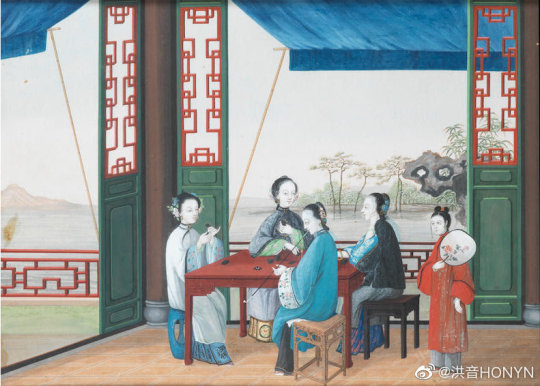
The blogger 盥薇 did a recreation of Jiaqing era dress based on export paintings, in her interpretation the sleeves are also still a little too long to be entirely practical but definitely not as long and drape-y as that in earlier centuries. This outfit might work as a reference for your costume, since it also features a cloud collar? (on a side note, the comment section of this video gives me psychic damage, please don't look)
About sheer, soft fabrics, yes they were indeed very popular around this time, and had been since the late Ming. Sheer clothes were usually meant for lounging around the house in warm weather and not worn outside, and sometimes you see women represented as forgoing underwear altogether. I'm not sure whether that's an artistic embellishment, but it does feel feasible given the domestic setting.
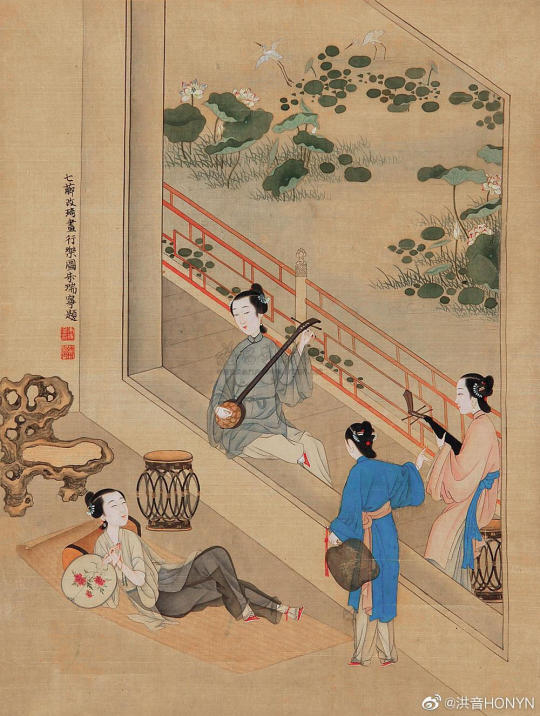

I explained in this post that the cliche of 'late Ming fashion continuing into the Qing' only actually applies to the 1650s. So the Jiaqing era, being in the early 19th century, has nothing to do with the Ming.
62 notes
·
View notes
Text
The Pool Scene - Jayson Shaw - US Open
New Post on http://thepoolscene.com/?p=22529
The Era of Shaw: Big Red Breaks Down the 42nd Annual U.S Open Championships
This past week 139 of the best players in the world took their shot at the U.S. Open 9 ball Championships. This is one of the most prestigious titles in pool along with the World Championships and the China Open.
One thing that has always intrigued me about the Open is that there are no politics involved, you do not have to have an invite from your national association, you do not have to have a world ranking. All you need is the self belief and skill to beat the best in the world.
It must be noted that after the passing of U.S. Open founder Barry Behrman the future of the tournament could have definitely been in Jeopardy. Luckily a rightful successor in Accu-Stats Productions headed up by Accu-stats founder Pat Fleming has emerged and it seems like the future of longest running tournament in the U.S. is in safe hands.
The landscape of the U.S. Open has changed a lot in the last five years and has become a testament to the popularity and high level that the game is being played at worldwide. This year over twenty countries were represented and to my knowledge this could be the first year in history that international entries outnumbered entries from the U.S.
One thing that hasn’t changed at the Open is the general format. For as long as I can remember the format has been winner breaks race to 11 on the winners and losers side. The double knockout long race format is another unique feature of the Open as most WPA international events are race to 9 preliminary stages that lead into a single knockout stage.
Play began on Sunday and ran through all the way to the following Saturday. As has been said every year for the past several years the field assembled this year was arguably once again the strongest field in the history of the 42 year event. At the risk of the article becoming to lengthy I will list some of the notable matches that brought about the final few players in this star studded field
All hill hill matches:
Babica over Immonen
Ko Pin Chung over Jones
Jiaqing Wu over Alcaide
Strickland over Owen
Ouschan over Filler
Shaw over Ko Pin Yi
Strickland over Kevin Cheng
Oi over Pagulayan
Thorpe over Biado
Chang Jun Lin over Immonen
Bergman over Morra
Kaci over Deuel
Chang Jun Lin over De Luna
Notable Performances of the week go out to first time competitors Josh filler and Jeffrey de Luna who finished 9th and 7th respectively. Corey Deuel also had a resurgent performance defeating most notably Albin Ouschan and Josh FIller among many strong victories over the week. Upstart Francisco Sanchez Ruiz had his highest finish in an international event ending up in third. Somewhat surprising was the absence of Taiwanese and Chinese players from the top ten although Chang Jun Lin and Ko Pin Chung both cracked the top six.
Nothing but praise can be given to the two finalists. I had the opportunity to watch a lot of the stream last week and the play of 19 year old Klenti Kaci was frankly astonishing. To my knowledge the only player ever of note from Albania, Kaci showed the poise of a player with twenty years of high level experience. Kaci’s run out style was conservative and he seemed to hold his nerve with veins of ice, a very bright future is definitely in store for him.
For the champion Jason Shaw this is his first huge crowning achievement on american soil. The former Kuwait open champion has won an astonishing number of events hes played in the last three years, perhaps a close to unprecedented amount. Considering there are only three or four majors a year it is nice to see someone that is clearly above the field on any given day be able to perform at his best on the highest stage. Huge congrats from myself personally and Cue Sport Nation as he is a friend of the site and one of the good guys in the game.
In conclusion it was a great show last week for me the only thing lacking was tv coverage and support from the billiard industry. The fact that cannot be ignored is that most players are not fully sponsored and when after expenses only 8 players turn a decent profit the financial side of the game remains a bit of a let down. Not for Shaw though as he pocketed $40 000 for the win. The level of play is growing by the day, the game is growing internationally, I really believe in my heart things are on the upswing, only time will tell.
0 notes
Text
Book review: Chinese Wallpaper in Britain and Ireland (2017) by Emile de Bruijn

*I wrote this last year but completely forgot to post it. Enjoy the old stock :)
I’ve seen a lot of interesting images from this book on Pinterest so I decided to get the real thing, and I have to say I am extremely satisfied with it. This book is about Chinese made wallpapers from the Qing Dynasty (mostly 18th and early 19th centuries) that were exported to Europe and used as decoration in British and Irish homes. Although wallpapers are an interesting subject on their own, I will only be reviewing it only on the basis of how useful it is for fashion history research. This will be a short one.
Great images
Apparently I was not the only person who got this book for the pictures as the review at the back of the book suggests, and I fully understand why. This book contains high quality photos of Chinese wallpapers from the 18th and 19th centuries, in perfect resolution and colors. Even if you’re not interested in Chinese fashion, I would still recommend you to get this book because it also shows beautiful antique British and Irish interiors and chinoiserie wallpapers, and is just plain pleasant to look at.
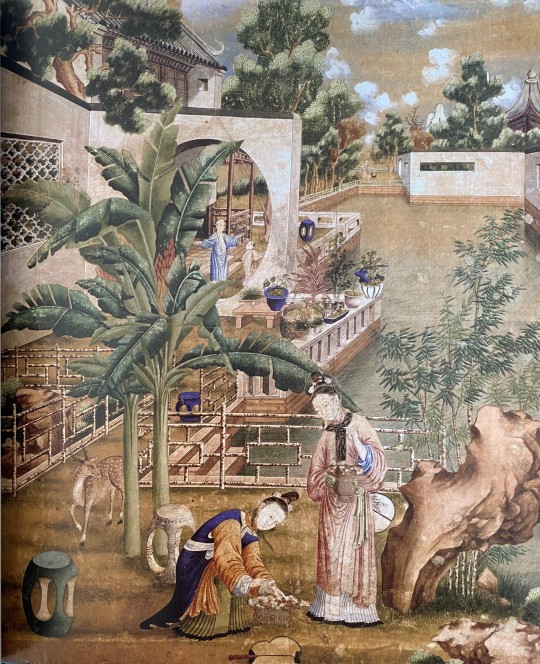
One of my favorites from the entire book, a full page spread with delicious details of a wallpaper depicting a Chinese garden using linear perspective. Even better that the ladies are clad in Qianlong era garments.
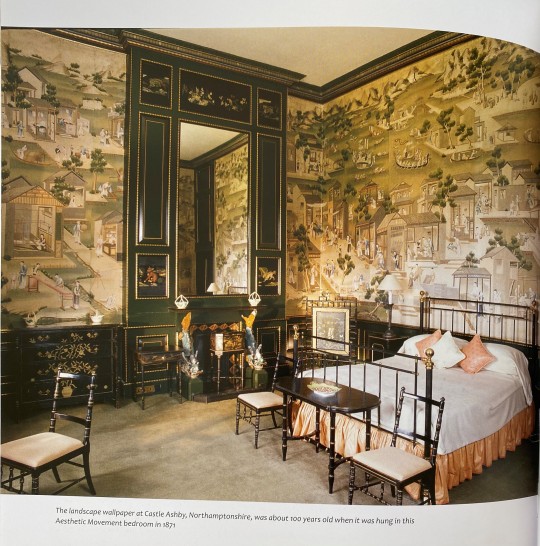
Photos of interiors are also immaculate.
The importance of commercial art
Commercial art like wallpapers, portraits and export paintings is very marginalized in the study of Chinese art, so I highly appreciate that this book sheds more light on a category that traditionally finds absolutely no favor with Chinese art historians. Because of commercialization and increased trade with Europe, popular artworks from this era that depicted life realistically often employed Western painting techniques at least to some extent, meaning they don’t look very Chinese and are often neglected by scholars; more stereotypically Chinese literati painting genres, such as landscape painting or 仕女画 shinvhua (idealized paintings of women) are definitely way more popular among art historians.
Literati painting seldom, if ever, depicted people’s clothing realistically. Costumes were meant to be excessively flowy, adhering to people’s imagination of deities and supernatural beings. Sometimes hints of contemporary fashion could be seen if you know what to look for, because the artist’s imagination had limits and they couldn’t just pull an outfit out of thin air. But still, literati paintings should never be used as resources for the study of fashion history, because the clothing shown had little to no connection to what was popular in real life. Commercial art, on the other hand, depicted real people with real fashion, but is seldom shown in museums or books on Chinese art history because it was considered vulgar and inferior by the literati upper class. In my opinion, commercial art is miles more interesting than literati painting, because literati art has changed relatively little over the course of Chinese history due to conservative Confucian morals, whereas commercial art was usually more reflective of their time and popular tastes. The only non literati Qing painter to ever receive mainstream attention was probably Castiglione, but he was also a court painter and didn’t belong in the commercial category. Even Lam Qua is niche. The commercial export paintings made by native middle class artists of the Guangzhou thirteen factories (十三行), who had more freedom and pioneered new art forms (like reverse glass painting), are rarely discussed.

Literati painting attributed to 焦秉贞 Jiao Bingzhen (active 1689-1726). The costumes of the women, which are extremely stylized and historicist, follow rules of the genre established centuries ago and do not reflect actual fashion. Jiao could paint in the Western style as well, I’m just picking a shinv piece he did. This is the type of stereotypically Chinese art historians love to focus on.

From Chinese Wallpaper, likely made in the late Qianlong era (1770s-1790s). This kind of more down to earth art illustrating everyday life is a lot more rare to see, especially those where the artist attempts Western shading or perspective.
Because “Chinese art” for most people only encompasses literati painting, calligraphy, ceramics and other such stereotypical disciplines, seeing the relative lack of them in the Qing it’s easy to jump to the conclusion that art was not produced with the same rigor as in previous dynasties, which then leads to notions about the Qing being conservative and uncultured and such. No, art was abundant in the Qing, it’s just that the popular taste in art has changed so it was often made in a different medium (oil painting, print and indeed wallpapers) using a combination of Chinese and Western techniques. Scholarship on mediums like oil painting (China trade painting) and reverse glass painting has been virtually nonexistent until very recently; the first thorough monograph of reverse glass painting I’ve read is Thierry Audric’s 2020 Chinese Reverse Glass Painting 1720-1820. I really hope that as research on Qing export art accumulates, it would be able to finally integrate itself into the wider timeline of Chinese art history. So on this matter, thank you de Bruijn for making a whole book on a niche category of Chinese art.
Underrated era
Now with the context out of the way, I can talk about fashion. Although there is no mention of fashion in the text since that isn’t what this book is about, the images included are great for illustrating fashion in the early to mid Qing, which is not well represented in the study of Chinese fashion history at all. I’ve talked multiple times about 18th century erasure on this blog, and I think this book is a very good antidote to that. The bulk of the wallpapers featuring humans were from the Qianlong era (1735-96), a personal favorite era of mine, and there are also several that depict the Jiaqing era (1796-1820), which is even rarer.
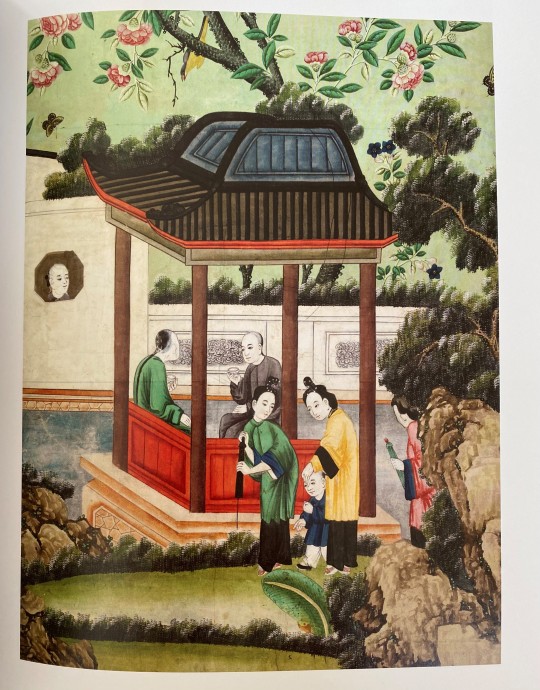
What seems to be Jiaqing era clothing. The unicolor robes with black binding paired with plain black pants or skirts have a very casual and pastoral look. The style is weirdly reminiscent of modern stereotypical “Republican era uniform” Halloween costumes, but way better.
Conclusion/rating
This is a short review because the main point is that this book has plenty of nice images of an underrated era. Without a doubt 9/10. One point off because it would be nicer if the wallpapers are dated, but that’s a minor qualm.
262 notes
·
View notes
Text
Note about periodization
I am going to start describing time periods in Chinese history with European historical terms like medieval, Renaissance, early modern, Georgian and Victorian and so on, alongside the standard dynastic terms like Song, Ming and Qing I usually use. So like something about the Ming Dynasty I will tag Ming Dynasty and Renaissance. I already do it sometimes but not consistently. Here’s why.
A common criticism levied against this practice is that periodization is geographically specific and that it’s wrong and eurocentric to refer to, say, late Ming China as Renaissance China. It is a valid criticism, but in my experience the result of not using European periodization is that people default to ‘ancient’ when describing any period in Chinese history before the 20th century, which does conjure up specific images of European antiquity that do not align temporally with the Chinese period in question. I have talked about my issue with ‘ancient China’ before but I want to elaborate. People already consciously or subconsciously consider European periodizations of history to be universal, because of the legacy of colonialism and how eurocentric modern human culture generally is. By not using European historical terms for non-European places, people will simply think those places exist outside of history altogether, or at least exist within an early, primitive stage of European history. It’s a recipe for the denial of coevalness. I think there is a certain dangerous naivete among scholars who believe that if they refrain from using European periodization for non-European places, people will switch to the periodization appropriate for those places in question and challenge eurocentric history writing; in practice I’ve never seen it happen. The general public is not literate enough about history to do these conversions in situ. I have accumulated a fairly large pool of examples just from the number of people spamming ‘ancient China’ in my askbox despite repeatedly specifying the time periods I’m interested in (not antiquity!). If I say ‘Ming China’ instead of ‘Renaissance China’ people will take it as something on the same temporal plane as classical Greece instead of Tudor England. How many people would be surprised if I say that Emperor Qianlong of the Qing was a contemporary of George Washington and Frederick the Great? I’ve seen people talk about him as if he was some tribal leader in the time of Tacitus. European periodization is something I want to embrace ‘under erasure’ so to say, using something strategically for certain advantages while acknowledging its problems. Now there is a history of how the idea of ‘ancient China’ became so entrenched in popular media and I think it goes a bit deeper than just Orientalism, but that’s topic for another post. Right now I’m only concerned with my decision to add European periodization terms.
In order to compensate for the use of eurocentric periodization, I have carried out some experiments in the reverse direction in my daily life, by using Chinese reign years to describe European history. The responses are entertaining. I live in a Georgian tenement in the UK but I like to confuse friends and family by calling it a ‘Jiaqing era flat’. A friend of mine (Chinese) lives in an 1880s flat and she burst out in laughter when I called it ‘Guangxu era’, claiming that it sounded like something from court. But why is it funny? The temporal description is correct, the 1880s were indeed in the Guangxu era. And ‘Guangxu’ shouldn’t invoke royal imagery anymore than ‘Victorian’ (though said friend does indulge in more Qing court dramas than is probably healthy). It is because Chinese (and I’m sure many other non-white peoples) have been trained to believe that our histories are particular and distant, confined to a geographical location, and that they somehow cannot be mapped onto European history, which unfolded parallel to the history of the rest of the world, until we had been colonized. We have been taught that European history is history, but our history is ethnography.
It should also be noted that periodization for European history is not something essentialist and intrinsic either, period terms are created by historians and arbitrarily imposed onto the past to begin with. I was reading a book about medievalism studies and it talked about how the entire concept of the Middle Ages was manufactured in the Renaissance to create a temporal other for Europeans at the time to project undesired traits onto, to distance themselves from a supposedly ‘dark’ past. People living in the European Middle Ages likely did not think of themselves as living in a ‘middle’ age between something and something, so there is absolutely no natural basis for calling the period roughly between the 6th and 16th centuries ‘medieval’. Despite questionable origins, periodization of European history has become more or less standard in history writing throughout the 19th and 20th centuries, whereas around the same time colonial anthropological narratives framed non-European and non-white societies, including China, as existing outside of history altogether. Periodization of European history was geographically specific partially because it was conceived with Europe in mind and Europe only, since any other place may as well be in some primordial time.
Perhaps in the future there will develop global periodizations that consider how interconnected human history is. There probably are already attempts but they’re just not prominent enough to reach me yet. Until that point, I feel absolutely no moral baggage in describing, say, the Song Dynasty as ‘medieval’ because people in 12th century Europe did not think of themselves as ‘medieval’ either. I am the historian, I do whatever I want, basically.
#I was watching an unrelated video about dnd worldbuilding#and out of nowhere someone in the comment section called 1300s chinese people 'ancient asians'#*facepalm*#so I was reminded of this again#rant#colonialism#orientalism#chinese history#historiography
927 notes
·
View notes
Text
A quick look into Noble Consort Ying
I was bored and rewatching Ruyi’s Royal Love In The Palace when something really interesting came to mind. Noble Consort Ying aka Barin Meiruo, our lady of shade, is an interesting character to say the least and I say so for the following reasons;
a) her noble birth; don’t get me wrong many of the women in the harem come from influential families of aristocracy. Yet, Meiruo is different; Qianlong has to constantly keep in mind that the Mongolian clans are extremely key for the peace of his nation and therefore he can’t really mess with her and in other words he is quite powerless against her. Everytime she calls him out or other women or more specifically calls out Imperial Noble Consort Ling he always kinda gives into her. Imagine having that power over the Emperor when she is just a minor consort of his! This may also have been historically accurate considering she had a considerable amount of power into the Jiaqing era
b) her upbringing; as a daughter of the head of the Barin clan, you expect she was brought up quite lavishly. However, there is very little conceit. If anything, her arrogance or strength comes from her clean conscience and strong character. Unlike Yanwan, she doesn’t rely on seduction or giving into Qianlong and unlike Yuyan, her clan power and again seduction isn’t the only thing that gives her power. It is because she is straightforward like Ruyi that really attracts Qianlong and that straightforwardness and good character can be attributed to her good upbringing which is why she doesn’t resort to harming other people for power.
c) her loyalty; it is almost a connection of souls when Ruyi and she meet. Ruyi meets a lot of people and she is quite hesitant about conversing them openly (ex Bai Ruiji). Yet with Meiruo they speak openly and become good friends. She confides her fears to her and Hailan, and doesn’t behave rudely with people who might not be as favored as her. Even when she loses her child, which she could quite frankly blame Ruyi for in her moments of pain, she doesn’t. Instead, their bond only grows stronger. Though she is favored, comes from a powerful clan and could blame Ruyi for her problems and overthrow her , she doesn’t. Even though her relationship with Ruyi isn’t like that of Hailan’s, Meiruo trusts Ruyi’s character and friendship. When Jingyuan tells Yanwan that she is a horrible woman for harming Ruyi, Meiruo backs her up and isn’t afraid of the repurcussion. During Ruyi’s funeral, everyone has tears in their eyes. Hailan knows Ruyi is in a better place and is sad that she couldn’t join her while Meiruo wishes that Ruyi should have finally gained some happiness.
d) her way with words; no one is spared from her angst or shade. Yanwan, Yuyan, and even Hongli has to bear the weight of her words. She tells each and every one of them what they ought to hear. She isn’t really afraid that she’ll lose Qianlong’s favor; her morality forbids her from not spitting out the truth and that is totally admirable. Her words don’t have anger; they are always straight to the point and hits the target. When she tells Jingse about the poor upbringing Yanwan is giving to her children, she doesn’t really mince words. She lets her know what an incapable woman Yanwan is and emphasises the fact that she wishes to become an Empress, like Jingse’s mom which is what really goes through to her and results in her downfall.
I wish I could have seen more of her but then again her significance wasn’t that large in the plot. I would like to know what the novel says about her and if she is as brilliant there as she was in the drama. Oh by the way, Noble Consort Ying is Rulan from Minglan (another unapolegtically amazing character)
#cdrama#cdramanet#ruyi#legend of ruyi#ruyi's royal love in the palace#ruyi zhuan#meiruo#random rants#ruyi meta
110 notes
·
View notes
Note
I've just finished ruyi and I've also watched yanxi and zhen huan as well, do you have any recs for other good court dramas in a similar vein? I'm weighing up my options but I can't decide :(
Sticking with the Qing dynasty, there is War and Beauty 金枝慾孽 and arguably the OG gongdou drama that gave popularity to the genre. Set in the Jiaqing era so immediately after Qianlong. Apparently there’s a sequel. Apparently it’s not as good.
Another Hong Kong/Cantonese series but this time set in the Tang dynasty: Beyond the Realm of Conscience 宮心計 (sequel Deep in the Realm of Conscience 宮心計2深宮計 out this year to apparently mixed reviews.)
Legend of Mi Yue 芈月传if you like Sun Li and/or Liu Tao. It’s not bad, it’s just a poor follow up to Zhen Huan for Sun Li.
Schemes Of A Beauty 美人心计 if you don’t mind Yu Zheng dramas and can find Engsub if you need it. This was a drama that happened before people realised what a horrible person Yu Zheng is, also arguably the drama that made his name. It doesn’t seem to be ripped off of some other story. It’s a decent enough drama and it’s actually the start of Yu Zheng’s “Beauty/Meiren” series. The other two dramas in this series are Beauty World唐宫美人天下 and In Love with Power山河恋·美人无泪, neither of which is very good. Honestly, l think Schemes Of A Beauty lured people into thinking the other two dramas and the Palace series could be good and then delivered massive disappointments.
I quite like The Virtuous Queen of Han 大汉贤后卫子夫 as well.
There are other dramas that isn’t exclusively harem drama but more political having harem subplots, e.g. The Glamorous Imperial Concubine, The Glory of Tang Dynasty, The King’s Woman, Bu Bu Jing Xin etc.
I always really hesitate to rec The Empress of China in asks like this. It fits the bill but this drama is so incredibly overrated on Tumblr that I feel like I don’t want to give it more attention. The clothes are lavish but the script is so bad. -H
#war and beauty#beyond the realm of conscience#deep in the realm of conscience#schemes of a beauty#legend of mi yue#the virtuous queen of han#drama rec#ask#where to watch#anonymous#han dynasty#qing dynasty#tang dynasty#warring states period
38 notes
·
View notes